
|
|
|
The distinctive
building at 60 Hudson Street in downtown New York City that served
as the Company's headquarters from its completion in 1930 through
1973 is shown front and center in the photo below. Many
members of the Association worked there at one time or another.
Although use of the building continued as a regional center, headquarters were moved to
northeastern New Jersey in 1973.
This photo, which looks north, shows West Broadway running vertically past the building to its right and Hudson Street breaking off West Broadway to the left in the immediate foreground. The Empire State Building can be seen about two miles in the distance.
|
|
|
The image was
taken from an advertising brochure sponsored by Seven World Trade Center and
distributed in the New York Times in November 2005. It appears to be
have been shot from the northeast corner of the World Trade Center South
Tower before its destruction September 11, 2001.
A similar, but taller and less ostentatious building constructed by and once occupied by the Long Lines Department of AT&T can be seen a few blocks beyond and to the right of 60 Hudson Street. New York Telephone occupied a building immediately to the left of where this photo was shot. RCA Communications and ITT Worldcom occupied other similar, but smaller, structures near what was once the financial district south of 60 Hudson Street near the tip of Manhattan. The building formerly serving as AT&T headquarters at 195 Broadway in lower Manhattan employed a different design concept. |
|
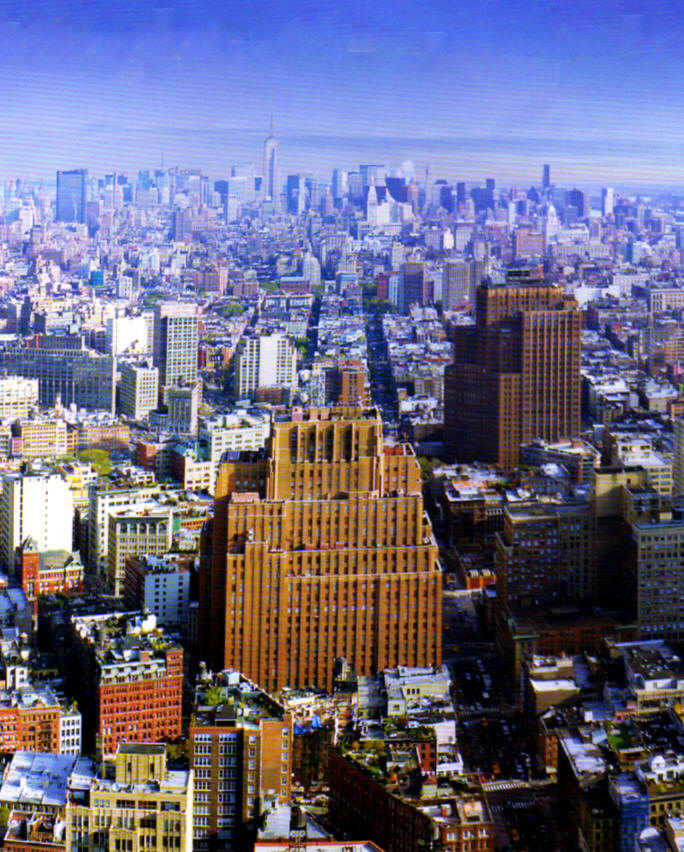 |
|
|
The Western
Union building was selected for protection by the New York City
Landmarks Preservation Foundation for its architectural
qualities in 1992. A plaque installed by the Commission in the lobby near the elevators says that the building is a "dramatically-massed art
deco skyscraper characteristic of a group of communications
buildings designed by Ralph Walker. Walker's preference
for brick is evidenced by a graded color scheme employing
brick in 19 shades, the use of brick ornament, and the vaulted
brick-faced lobby". Besides office space, the building
contained a restaurant and gymnasium for employees, 70
million feet of wire and 30 miles of conduit. It is also
notable for having been originally wired for direct current
electrical power, for serving as a terminal for a pneumatic tube
system used for the physical transmission of printed messages
under the streets of downtown Manhattan, including, of course,
telegraph communications, and for containing a brick-enclosed
collection box at the bottom of the mail chute on the lobby wall
that is a miniaturized representation of the exterior of the
building. Several street level photos of the building and
additional information about its history can
be seen at
http://www.nyc-architecture.com/SOH/SOH016.htm..
60 Hudson Street now has other owners, but retains its original appearance and is still occupied by companies in the communications industry. It is called a "carrier hotel' in the trade, and is one of two with that designation in New York. Gaining access to the building is difficult now because of the high level of security maintained. The top seems to have grown bristles of antennas since the Trade Center towers, which served as a communications center, went down. Another photo of the building with recent information about its current use can be seen at http://www.carrierhotels.com/news/September2001/60hudson.shtml. Art deco architecture implies buildings put up in the period of rapid business expansion before the depression of the 1930s, and is usually characterized by long thin forms and straight lines, although the Western Union building departs from this norm in that it is not topped by a tower. Numerous buildings employing art deco styling were built to Ralph Walker's designs, including several grouped together in the financial district of downtown Manhattan. The most famous of those buildings is probably that built for the Irving Trust at 1 Wall Street. Several depictions of the building and information about it can be seen at http://www.nyc-architecture.com/LM/LM051-BANKOFNEWYORK.htm. Three art deco buildings were constructed in the late 1920s and early 30s for telecommunications companies in lower Manhattan that stood distinctively apart from their surroundings. In addition to the two shown in the above photo, the 32 story structure that originally served as headquarters of the New York Telephone Company, known as the Barclay-Vesey Building for the streets that border it on the north and south, was completed in 1927 and is considered to be the first art deco skyscraper. It was built on what was then the Hudson River waterfront immediately to the left of the site at which the above photo was taken. Its design won awards at the time it was constructed, and its vaulted lobby is now an official interior Landmark. It was adjacent to the World Trade Center towers and was badly damaged by steel beams falling into it in the attack on the towers. Go to http://www.nyc-architecture.com/LM/LM070.htm to view the building as originally constructed and browse down to see it as it appeared after 9/11. A photo showing how it appeared after the Towers were built and before the attack can be seen by browsing down about five photos at http://www.nyc-architecture.com/GON/GON001.htm. Note how buildings on the landfill into the Hudson obscured the view of Barclay-Vesey. Through a series of mergers after the breakup of the Bell System, New York Telephone became New England Telephone, then Bell Atlantic, and then Verison, which is not headquartered in midtown Manhattan. It was recently reported by the NYTimes that Verizon intends to move its corporate headquarters back into the Barclay-Vesey Building as soon as its renovation is completed. Although less well known, the ATT Long Lines building in the photograph above is also a New York City Landmark. It was recently renovated and now has other uses. It can be seen at http://www.nyc-architecture.com/SOH/SOH005.htm. Its functions were absorbed by a stark, and taller building now known as the ATTT Long Lines Building constructed in 1974 about three blocks east of 60 Hudson Street that can be seen at http://www.nyc-architecture.com/SOH/SOH026.htm. The Association recently installed a plaque commemorating the Western Union Building's earlier, but important role in our County's history at its main entrance, as documented below. |
|
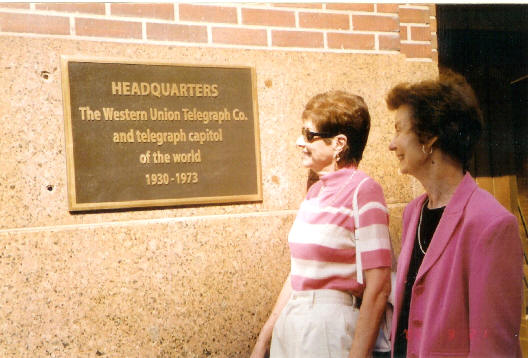 |
|
Board
members Jackie Velton, at left, and Jean Stritt are shown viewing
the new plaque commemorating the Western Union Telegram Company
headquarters building at 60 Hudson Street in New York City at its
dedication ceremony September 22, 2005.
Although the building's address is 60 Hudson Street, the plaque is
installed at the entrance on West Broadway, which is the one most
frequently used.
|
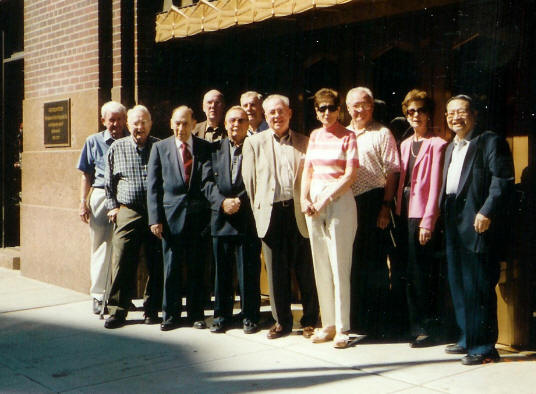 |
| The ten Board members attending the ceremony were, from left, John Durkin -- newsletter editor, John Skelton -- Association President, Al Bianco, James Riley, James Fobes, Robert McCluskie -- Association Secretary, Paul Lohiser, Jackie Velton, John Wilkinson -- website editor, and Jean Stritt. Joe Tieng, a member of the Association served, as the group's photographer and is shown at right. |
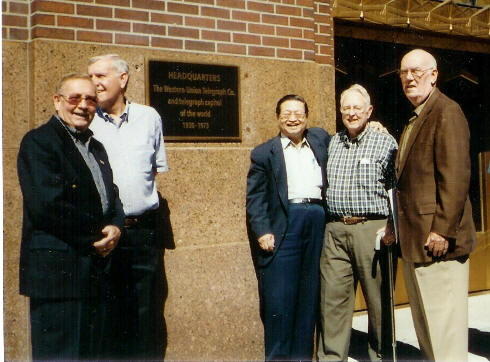 |
|
From left, Jim
Forbes, Bob McCluskie, Joe Tiang, John
Skelton, and Jim Riley stand near the newly
installed Plaque at the West Broadway entrance.
Robert McCluskie managed the
project, which involved protracted negotiation with the building's
present owners and with the Landmark Commission over a considerable
period of time. He deserves considerable praise for his dogged
effort.
|
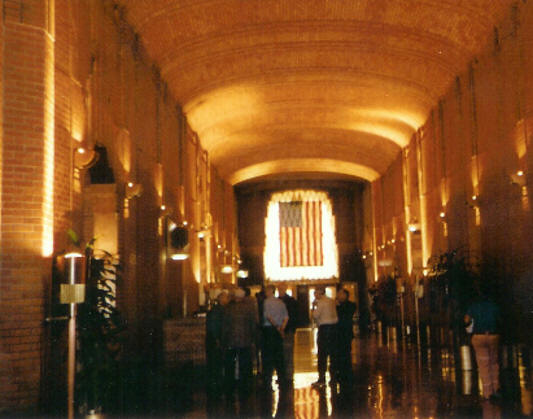 |
| This view of
the lobby is taken from the Hudson St. entrance on the west and looks
eastward toward the
West Broadway entrance. The security guard's stand is on the
left. The plaque installed by the City commemorating the
building's designation as a New York City Landmark building is on the right
opposite where the group is standing and is near the
elevators.
|
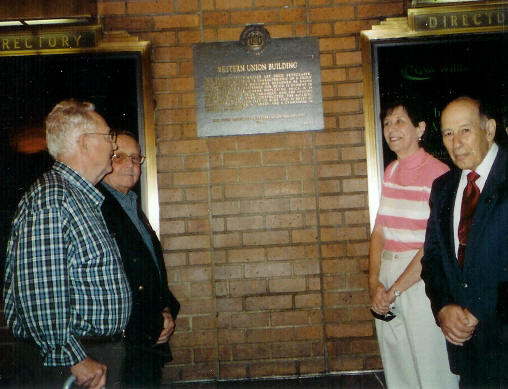 |
|
From left,
John Skelton, Jim Forbes, Jackie Velton, and Al Bianco stand near the
Plaque
commemorating the
building's selection as a New York City Building Landmark. John is the current president
of the Association, and Al served several years in the same
capacity in more difficult times when the Company was facing
bankruptcy.
|
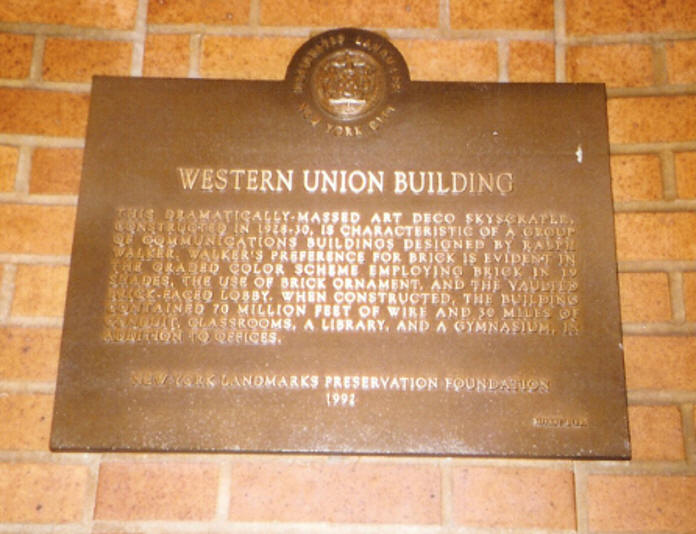 |
| This is a closeup of the plaque commemorating the building's selection as a New York City Building Landmark. |
Posted 12/21/05, revised 12/29/05.
Website designed and hosted by Path Computer Systems